
 |

|
| |
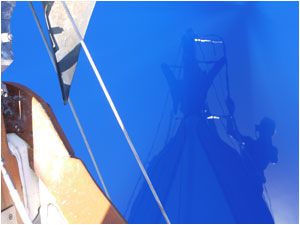
|
|
 |
Day 1,216 - Navadra, Fiji (17° 27S 177° 02E)
11:07hrs - September 28th 2010
Secret Garden |

Neville will tell you I’m a very picky snorkeler, but I just say, for an agreeable Catherine snorkel, we need a cloudless blue sky, balmy tropical air, warm calm clear water, lots of pretty coral and a selection of interesting fish, oh, and the place to ourselves would be nice too, not too much to ask for right? But you’d be surprised how often those things don’t actually happen on the same day. Often you’ll get one or two at the same time, but everything, all at once, well, we might be living in paradise but you’ll be pleased to hear, we don't always get what we want.
However, today was indeed my very own snorkelly day. We sailed back to Navadra a striking, deserted and apparently sacred island that we had taken our nephew to last month (P.S. I still miss him), and hey presto! the blue sky showed up. Followed cheerfully by the balmy air and the warm calm clear water, we even had the bay miraculously to ourselves. The stars had aligned beautifully and all I had to do, was dive in. So began the best snorkelly day ever. I floated blissfully above the perfectly lit kaleidoscopic fish and coral all day and I felt like I had discovered a secret garden. But instead of trees and flowers there were acres and acres of vibrant healthy coral, and instead of birds, there were fish of every shape and color, and in this garden I flew over the flowers instead of walking among them, and all of it hidden cleverly beneath a casually mysterious sea. Today I spent longer in the water than I ever have before, and I may just do it all again tomorrow, conditions permitting of course! |
|
|

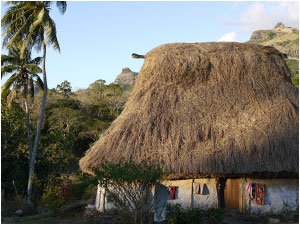
|
|
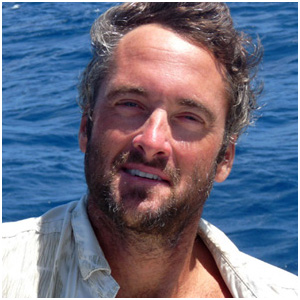 |
Day 1,205 - Mana, Fiji (17° 40S 177° 06E)
17:57hrs - September 17th 2010
History |

Last week we traveled back in time, or at least, for a few days, it felt a little like we did.
We spent the last week with our intrepid nephew Jono - who flew over from London to join us for a
month - exploring Fiji's largest island by 4X4. From cruising the picturesque tradewind-swept Coral Coast along Viti Levu's southern shore, to driving inland, up rocky, corrugated dusty roads to the highlands, we circumnavigated the island around its perimeter road, making pit stops along the way; sand-surfing at the Sigatoka dunes, witnesses a Fijian priest walk on white-hot river rocks during a fire-walking ceremony in Pacific Harbour, to wandering aimlessly around the bustling city of Suva - Fiji's capital, on a warm Saturday evening. But the highlight of our excursion was discovering Fiji's last remaining traditional village, Navala, nestled away in a valley between Viti Levu's two largest volcanic peaks - Tomanivi
and Koroyanitu.
We arrived in Navala on Sunday afternoon after traversing areas of the King's Road which, according to locals, has been under construction for over three-years. Driving our 4X4 across narrow rickety wooden bridges and over terrain that would make the rental car company cringe, we rolled, rocked and skidded our way up loose-gravel roads, around potholes, landslides and into the Nausori Highlands.
Navala village has been located in the valley for hundreds of years, and while the bures - traditional thatched-roofed homes with bamboo-woven walls, may have been relocated and rebuilt over the generations, life in Navala remains much the same today as it did, say, when Captain Cook first visited the islands back in the 1700s. Sure a handful of the 800 residents have small generators and portable TVs where family and friends gather to cheer for their favorite rugby team, but Navala is off the grid, and outside of the occasional interruption from visiting tourists, is free from most modern conveniences and remains almost completely independent and self-sufficient.
We spent the late afternoon wandering around the grassy slopes of the village waving at smiling children who appeared from the tiny darkened doorways of almost every bures we strolled past. Our guide and host for the night, Tui - son of the late village chief, Seresio Talili, explained that families and friends work together to grow food, rear cattle, and during a two-month window when materials are abundant, repair and construct new bures for their growing community.
Many families own two bures - one dedicated for cooking, and another slightly larger bures for sleeping, where up to eight people, three generations, would curl-up together on woven bamboo mats within a single room no larger than a double-car garage. Each cluster of neighboring bures is home to relatives, and each new generation builds around the family, expanding out like a life-size genetic flowchart. Great-grandparents, grandparents, parents, brothers, sisters, uncles, aunties, cousins and nephews, all sharing the same patch of grass. It's a comforting, yet at the same time, frightening thought, and a way of life that is as foreign to me as I'm sure our life is to them.
The sun settled too quickly behind the ridge, casting long shadows across the hillside and softening the rows of thatched roofs. The rhythmic sound of kava-pounding echoed through the village and as children burned-off the last of their energy, laughing and running barefoot down grassy streets, parents gathered in groups, sitting on the smooth stones from the Ba River bed that form the foundation for most homes. Our tour was over and regrettably it was time to leave.
Tui led us away from the village, half a mile up a dry dusty road to his home, the Bulou Eco Lodge, where we took turns pounding his homegrown kava into a fine powder before the three of us settled down with his mother, Bulou, for an evening of kava drinking and relaxed conversation. By ten o'clock we were exhausted, and with slightly numb-lips and furry-tongues, a result of a few too many bilos of kava each (coconut cups), and with the soft glow from a hurricane lamp to show the way, we retired to our own little bures by the river, next to a traditional Fijian village in a distant valley that felt untouched by time. |

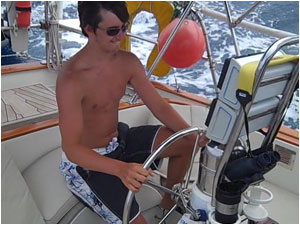
|
|
 |
Day 1,201 - Mana, Fiji (17° 40S 177° 06E)
21:03hrs - September 13th 2010
Where's Jono? |

After one last week on the road exploring Fiji, our intrepid nephew Jono left us, and flew back to his real life back in London (and soon Nottingham University), and we haven’t stopped missing him yet. His month with us in Fiji shot past so quickly that it feels like we only just picked him up from the airport 5 minutes ago and now he’s gone already!
Having never been this far, and this long away from home before, we weren’t sure how successfully he would or would not adapt to a long month at sea aboard the good ship Dream Time. It should also probably be pointed out that we have never had visitors for longer than two weeks before, so we were also a little curious as to how well we would acclimatize to a third member of crew, but within a day everyone was settled in, and it was as if our shipmate Jono had always been there. He quickly developed all the requisite boaty skills to make life aboard entertaining. The first day out he mastered the one minute shower, and after only a few anxious reminders, he got the ‘ turn the fresh water tap off ASAP’ rule, and after that the close the fridge, you’re letting all the cold out, rule. He even had his first Spam-a-la Dream Time encounter, not a rule exactly, but just to answer the whole ‘what do sailors eat after a month at sea’ question. He was even a good sport about all our sometimes peculiar but important boat and at sea rules, especially considering that normal life for him for the last 18 years has been a family and pet filled home in London replete with never-ending supplies of electricity, fresh water and a huge refrigerator that re-stocks itself on a daily basis.
So bottom line, he was a natural, and he can come back anytime!
|

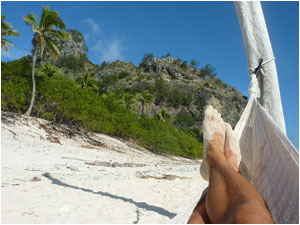
|
|
 |
Day 1,191 - Musket Cove, Fiji (17° 46S 177° 11E)
11:30hrs - September 3rd 2010
A New Life Discovered |

Ten years ago I first watched Tom Hanks in the movie Cast Away, it's a story about a man marooned on a remote, uninhabited South Pacific island, it's a story of adventure, survival and discovery. The film's message resonated with me as it was released the same year we bought a rather worn 1981 Cabo Rico.
This was long before we had the means or any tangible plans to sail around the world. It was back when this voyage was a dream - just an idea of a life we wanted to live. A life that felt as remote to our reality then as the South Pacific island did to Tom Hanks' character in Cast Away. But what we did have was the conviction, the absolute belief that we would one day achieve our dream and explore the world, to sail over the horizon and to have the freedom to live a life that would reset our priorities.
We've traveled a long way in the past ten years, and yesterday, after sailing down through the Yasawa Islands along Fiji's western border, we visited Monuriki, the island featured in Cast Away.
We dropped our anchor on the steep seabed just a few boat lengths from the shoreline, off the recognizable beach where Tom collected his water-logged FedEx packages a decade ago. It didn't matter that Monuriki, the island portrayed in the movie as being isolated and remote, is in fact part of the Mamanuka-I-Cake Group and surrounded by half a dozen other similar islands. Or that Seaspray, an eighty three foot wooden charter schooner, had just delivered over forty tourists and was moored off the same beach. It didn't matter because we had sailed our Cabo Rico over 15,000 nautical miles to an island that once existed to us only on the big screen, an island an ocean away from our old lives, one that represented a distant and undiscovered world.
Seaspray left us alone with Monuriki in the early afternoon, and even though we were exposed to the southeast, and the steep beach allowed just a paltry 3:1 anchor scope, the tradewinds were light and the barometer was steady, so we stayed for the night.
Our afternoon was spent wading around the shallow lagoon waters surrounded by dense schools of bait fish and the occasional blacktip shark. We hiked up the center of the island, following goat trails to the rocky summit. We gathered driftwood for a beach fire and rigged a hammock on the beach. We spent the evening roasting marshmallows over an open fire under a clear moonless night sky saturated with stars.
In the morning, before Seaspray delivered its first load of tourists, I spent an hour swinging in a hammock, the only noise was the gentle and rhythmic sound of waves caressing the sandy shore. Catherine and Jono were on Dream Time, and I was alone on a tiny island in the South Pacific, living a life that a decade earlier would have seemed like a dream, a grand adventure, or, perhaps, just a really, really good movie. |

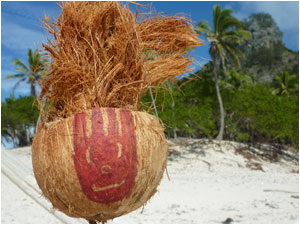
|
|
 |
Day 1,189 - Musket Cove, Fiji (17° 46S 177° 11E)
08:36hrs - September 1st 2010
Not a Dull Moment |

It is now my fourth week on board Dream Time, and life is gooooood!
I spent last night in a hammock on the sandy shore of Monuriki Island, which is now more commonly known as Tom Hanks' Island, as it was where the movie Cast Away was filmed. Equipped with a bottle of water, a torch and our own version of Wilson to keep me company, I managed to get a few hours of sleep, and was woken at dawn as the sun crept over the horizon.
A lot has happened in the past couple of weeks. After swimming with the manta rays, we went on to Narewa Bay off of Somosomo Island. The beach there was covered with shells, of which we collected a nice little bundle. We took a walk through the dense forest and grassland that covers the middle of the island and emerged on the other side in a small sparsely populated fishing village. After meeting briefly with the few people we encountered, we were able to dive down on the East side of the island and see the remains of a WWII aircraft. Although I found the lack of a skeleton somewhat disappointing, the tail end of the wreck was still pretty much intact, forming a perfect home for many inquisitive clownfish and a large sea cucumber.
I went on my second scuba dive in Blue Lagoon. Hanging onto a rope tied to the ocean floor 22 metres underwater, we all waited as our guide appeared from above holding a large trashcan full of dead fish, which he proceeded to empty about 20 feet in front of us. The reaction was immediate as hundreds
of fish descended at once upon the food. Watching this, I couldn’t help but feel slightly annoyed by how many large, meaty creatures there were just in front of us when we had only managed to catch a single relatively small fish in two weeks of relentless trawling. My annoyance didn’t last long however, as I was distracted by the things that we had come to see gliding through the water towards us – sharks.
It was my first up-close shark encounter. There were a few different varieties, but the lemon sharks were the most impressive to watch. Over 4 metres in length, they would move lazily down to the ocean floor before grabbing a carcass in their teeth and swallowing it whole. Time flew by as we watched, hypnotized by the display, until our air began to run low and we ascended.
We departed from Blue Lagoon and continued on to Sawa-i-Lau, one of the most beautiful anchorages we have visited so far. We visited the local village and offered a bundle of kava to the villagers so that we would be permitted to visit their limestone caves. The next morning we arrived at the caves slightly early to avoid the throng of tourists not far behind. The caves themselves were spectacular, and apart from almost splitting my head open as I surfaced right underneath a rocky ledge, the calm, tranquil areas of darkness ensured a very enjoyable morning.
Another enjoyable (yet decidedly more energetic) morning was spent hiking to the top of Waya Island. Although getting to the summit proved to be quite a challenge for someone who has spent the last couple of weeks lounging around in the sun, the view from the top was breathtaking, and the descent was great fun as I tried to discover just how fast I could travel downhill without injuring myself. The food served at the nearby resort was so good that it resulted in us staying an extra day just so that we could eat there twice!
The fun hasn’t stopped for one second in Fiji. We continue to meet new and interesting people every day, we anchor off enchanting islands, we (occasionally) catch fish and eat them fresh that evening – while I was writing this blog we were even pulled over by the border police. Not a dull moment so far, and I don’t anticipate any for the duration of my stay. |

|
|








![]()